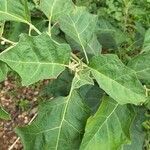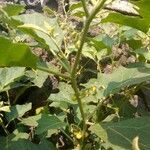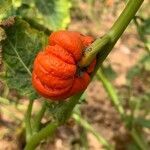A herb or shrub. It grows 1-2 m tall. It can grow from 2 to several years. The leaves have shallow lobes. There are 2-6 flowers. The fruit are large, round and uneven shape. They are orange-red. Fruit shape can vary. There are 3 main sub groups. One is mainly for fruit and the other is mainly for leaves.
White or pale violet flowers up to 2/3 in. diam.
Globose, red shining fruits up to 3/4 in. diam.
A glabrous herb up to 2 ft. high



